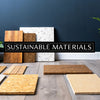9 Eco Friendly Interior design Ideas for 2025
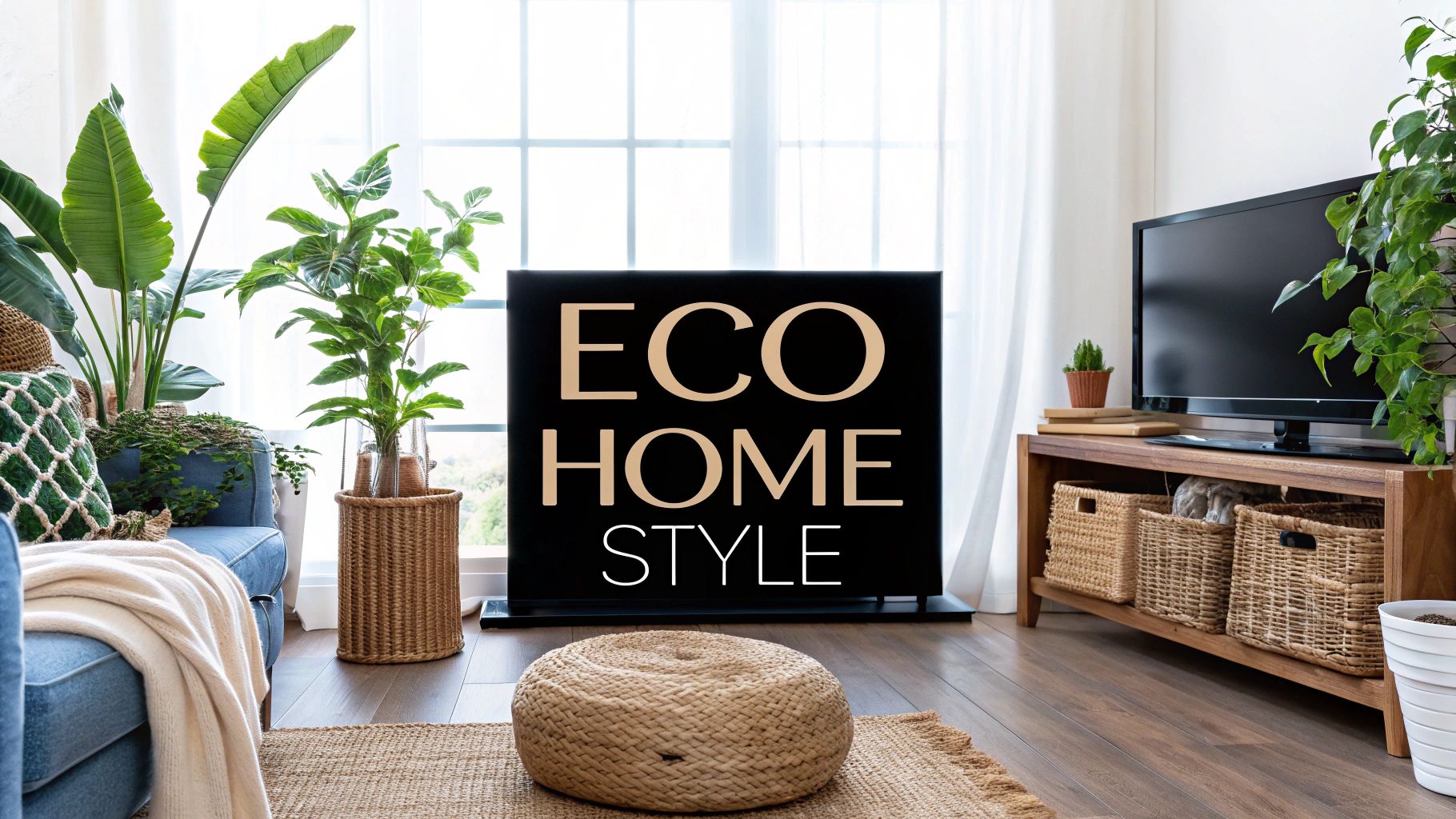
Designing a Greener Future: Your Guide to Sustainable Style
As environmental consciousness becomes a priority, the spaces we inhabit are a focal point for sustainable living. Eco-friendly interior design has moved beyond a niche trend to become a powerful movement for creating homes that are not only beautiful and functional but also kind to our planet and beneficial for our personal health. This approach prioritizes long-term well-being and responsible consumption over temporary aesthetics, proving that great design can be a force for good.
This guide moves beyond the abstract, offering a collection of tangible and impactful eco friendly interior design ideas you can implement today. We will explore how thoughtful choices in materials, technology, and decor can drastically reduce your environmental footprint without compromising on style or sophistication. You will gain practical, actionable insights into transforming any space, from a single room to an entire commercial fit-out, into a model of green design.
We will cover everything from foundational elements like sustainable furniture and non-toxic finishes to the air you breathe and the energy you use. Each of the nine concepts presented provides a clear path towards a healthier, more responsible home environment. Prepare to create a space that is a true sanctuary of sustainable elegance, proving that high design and deep-rooted environmental values can coexist beautifully.
1. Sustainable Furniture Materials
The foundation of any eco-conscious space begins with the largest items in it: the furniture. Choosing pieces crafted from sustainable materials is one of the most impactful eco friendly interior design ideas you can implement. This approach prioritises materials like rapidly renewable bamboo, character-rich reclaimed wood, and hardwoods sourced from responsibly managed forests, significantly reducing your home's environmental footprint while adding natural beauty.

Why Choose Sustainable Materials?
Sustainable furniture offers more than just environmental benefits; it brings durability, style, and a unique story into your home. Materials like reclaimed timber, for example, feature distinctive grains and a history that new materials simply cannot replicate. Similarly, companies like Greenington have popularised bamboo for its incredible strength and sleek, modern aesthetic, proving that sustainability does not require compromising on design. These choices support a circular economy and result in high-quality, long-lasting pieces that become cherished parts of your home.
Actionable Tips for Sourcing Furniture
When selecting new furniture, look for official certifications to verify its green credentials. For wood products, seek out the Forest Stewardship Council (FSC) or Programme for the Endorsement of Forest Certification (PEFC) labels, which guarantee the timber was harvested responsibly.
- Go Vintage: The most sustainable option is often pre-loved. Sourcing antique or vintage pieces prevents landfill waste and adds timeless character.
- Invest in Longevity: Prioritise well-crafted furniture built to last for decades, reducing the cycle of consumption and disposal.
- Consider the Full Picture: Don't forget the fabrics. When reupholstering a vintage find or choosing a new sofa, you can explore top green upholstery material ideas for eco-friendly furniture to complete your sustainable vision.
2. Non-Toxic Paint and Finishes
A fresh coat of paint offers one of the quickest ways to transform a room, but conventional paints can release harmful Volatile Organic Compounds (VOCs) into your home for years. Opting for low-VOC or zero-VOC paints, stains, and finishes is one of the most impactful eco friendly interior design ideas for improving indoor air quality. These products deliver vibrant colour and durable coverage while eliminating harmful off-gassing, creating a healthier and more pleasant living environment.
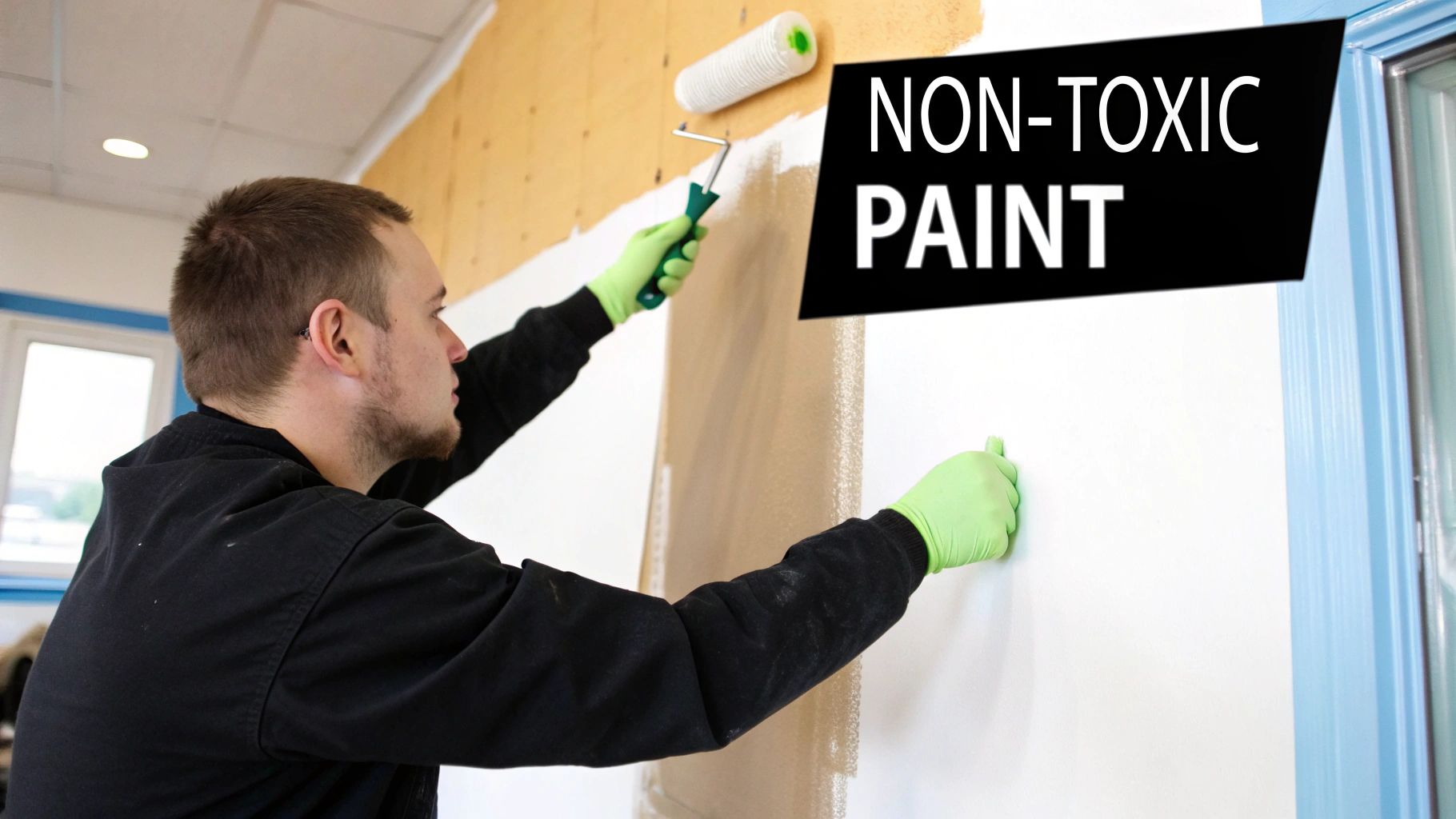
Why Choose Non-Toxic Finishes?
The primary advantage of non-toxic finishes is the significant improvement in indoor air quality, which is crucial since people spend most of their time indoors. VOCs are linked to health issues ranging from headaches to respiratory problems. Leading brands like Benjamin Moore with its Natura line and Sherwin Williams' ProMar 200 Zero VOC have demonstrated that you don't need to sacrifice performance for safety. Choosing these products aligns with top environmental standards, such as the Green Building Council's LEED certification, making your space safer for occupants and kinder to the planet.
Actionable Tips for Eco-Friendly Painting
To achieve a flawless, professional finish with non-toxic paints, a few specific techniques can make all the difference. Proper preparation and application will maximise the paint's performance and longevity.
- Seek Out Certifications: Look for official labels like Green Seal or other third-party certifications to verify that a product's low or zero-VOC claims are legitimate.
- Prime Surfaces First: Always use a compatible eco-friendly primer to seal the surface. This ensures better adhesion and true colour, often reducing the number of topcoats required.
- Test Your Colours: Natural pigments can interact with light differently. Paint a small test patch in your space and observe it at various times of the day before committing.
- Store Leftovers Properly: To ensure you have paint for future touch-ups, seal the can tightly and store it upside down in a cool, dry place to create an airtight seal.
3. Energy-Efficient Lighting
Illuminating your home thoughtfully is a cornerstone of modern eco friendly interior design ideas. This involves a two-pronged approach: maximising natural light through clever design and adopting advanced technologies like LED systems and smart controls. By strategically placing fixtures and using systems that respond to your needs, you can drastically cut energy consumption while enhancing the beauty and functionality of your space.
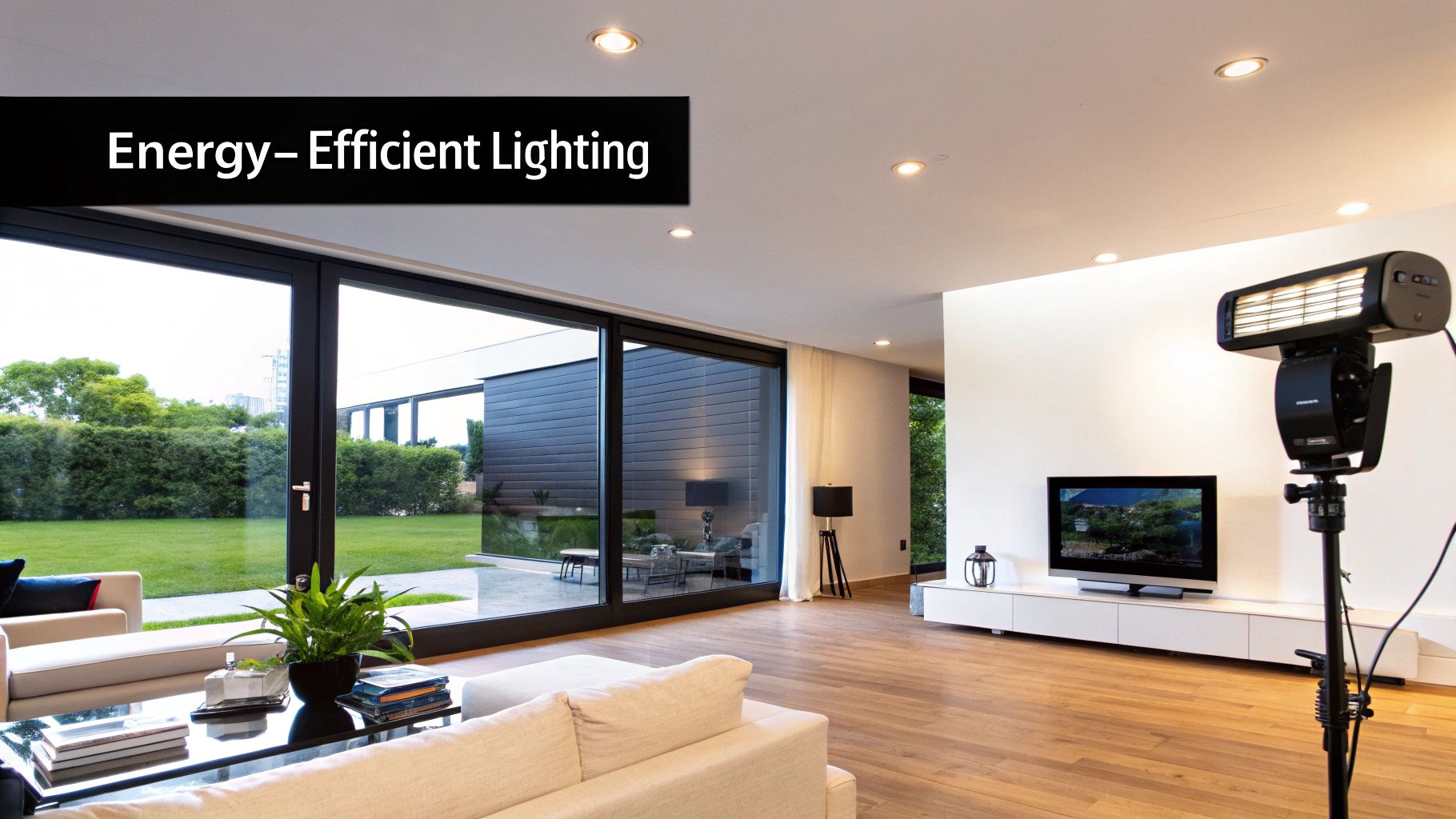
Why Choose Energy-Efficient Lighting?
Beyond significant energy savings, modern efficient lighting offers superior quality and longevity. LED bulbs last up to 25 times longer than traditional incandescent bulbs, reducing waste and replacement costs. Systems from innovators like Philips Hue and Lutron allow for unparalleled control, enabling you to automate schedules, dim lights for ambiance, and even change colour temperatures. This proves that sustainability can elevate your home's atmosphere, not just make it more efficient.
Actionable Tips for Smart Lighting
When implementing an energy-efficient lighting plan, focus on both the technology you choose and how you integrate it into your design.
- Choose Warm Tones: For living areas and bedrooms, select LED bulbs with a warm colour temperature between 2700K and 3000K to create a cosy, welcoming environment.
- Install Dimmer Switches: Dimming is one of the easiest ways to save energy and set the perfect mood. Smart dimmers like the Lutron Caseta system offer even greater control via apps and voice commands.
- Use Task Lighting: Instead of illuminating an entire room with powerful overheads, use focused task lights like desk lamps or under-cabinet strips for specific activities like reading or cooking.
- Maximise Daylight: Position mirrors and use light-coloured paint on walls opposite windows to reflect and amplify natural light, reducing the need for artificial sources during the day.
- Consider Daylight Sensors: For the ultimate in efficiency, install daylight sensors that automatically dim or turn off artificial lights when there is sufficient natural light available.
4. Indoor Air-Purifying Plants
Integrating living greenery is one of the most effective and beautiful eco friendly interior design ideas for enhancing your home's health and atmosphere. Beyond simple decoration, certain houseplants act as natural air purifiers, actively filtering out common indoor pollutants. This biophilic approach connects your space with nature, improving well-being and air quality based on principles identified in the landmark NASA Clean Air Study.
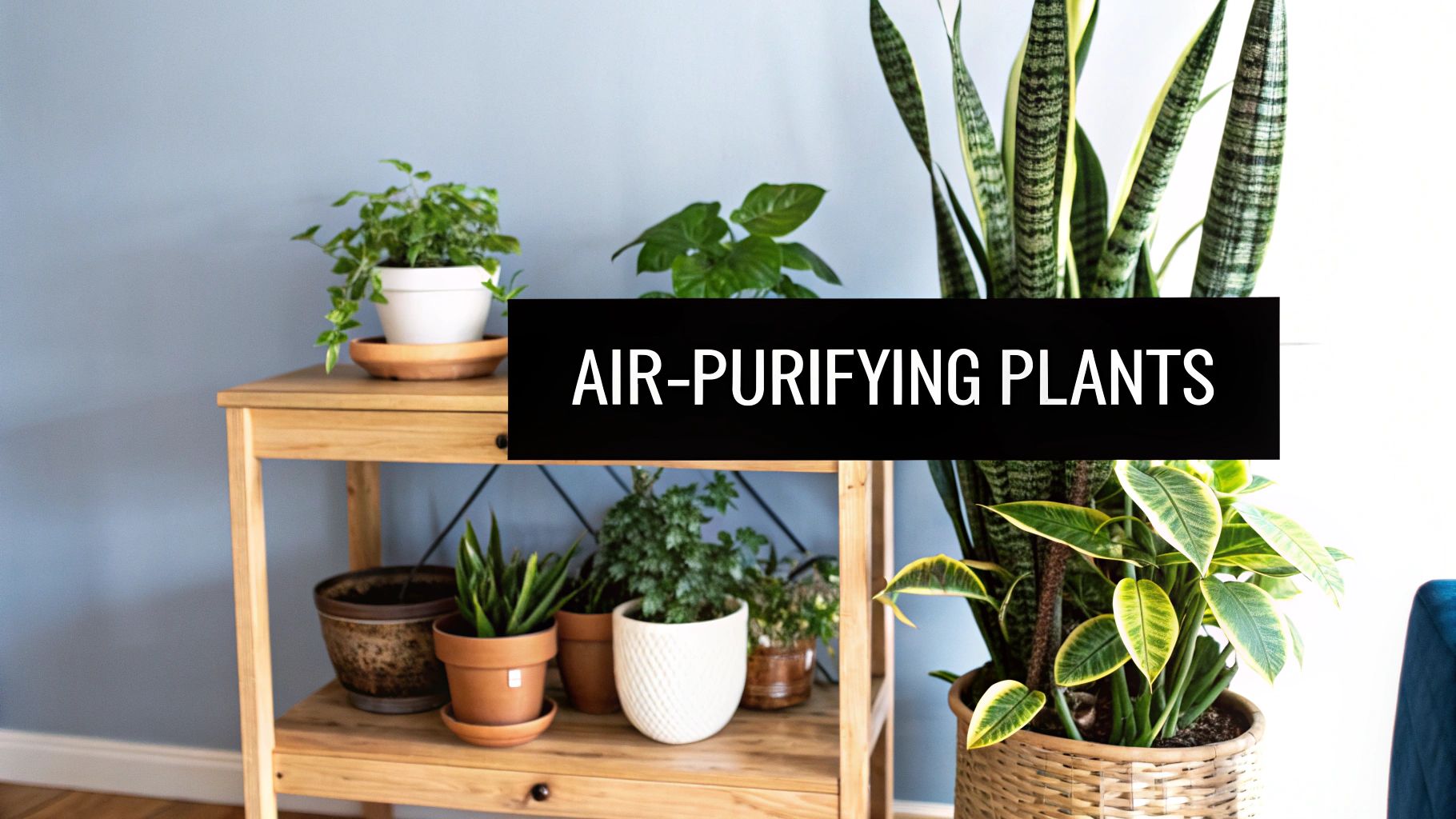
Why Choose Air-Purifying Plants?
Strategically placing air-purifying plants improves indoor air quality by removing toxins like formaldehyde, benzene, and trichloroethylene, which can off-gas from furniture, paints, and cleaning products. For instance, a Snake Plant in the bedroom releases oxygen at night, promoting better sleep, while a lush Peace Lily thrives in a humid bathroom, tackling mould spores. These living elements add texture, colour, and life to a room, proving that sustainable choices can be both functional and stunningly beautiful.
Actionable Tips for Greening Your Space
To maximise the benefits, consider the strategic placement and care of your indoor garden. A thoughtful approach ensures your plants thrive and effectively contribute to a healthier environment, turning your home into a green sanctuary.
- Plan for Density: As a general rule, aim for at least one medium-sized plant per 100 square feet to achieve noticeable air-purifying effects.
- Match Plants to Light: Select plants based on your home’s specific light conditions. A versatile Pothos can tolerate lower light in an office, while a Spider Plant thrives in the bright, indirect light of a kitchen.
- Group for Impact: Cluster plants together to create a lush focal point. This not only makes a strong design statement but also helps increase local humidity, which benefits many tropical plant species.
- Choose Complementary Planters: Select pots made from natural materials like terracotta, stone, or ceramic that enhance your interior design scheme and provide proper drainage for plant health.
5. Sustainable Flooring Options
Flooring is a dominant feature in any room, and choosing sustainable materials is one of the most effective eco friendly interior design ideas for reducing your home's environmental impact. This approach moves beyond traditional options to embrace innovative materials like rapidly renewable bamboo and cork, beautiful reclaimed hardwood, and stylish recycled tiles, laying a green foundation for your entire space.
Why Choose Sustainable Flooring?
Beyond their green credentials, sustainable floors offer superior performance and unique aesthetics. Cork, popularised by specialists like US Floors, provides excellent thermal and acoustic insulation, making rooms quieter and more energy-efficient. Companies like Cali Bamboo have demonstrated the incredible durability and sleek look of strand woven bamboo flooring. Meanwhile, reclaimed hardwood from sources like Vintage Timber brings unparalleled history and character, and options like Daltile's recycled glass tiles offer a durable, modern finish for kitchens and bathrooms.
Actionable Tips for Sourcing Flooring
Proper selection and installation are key to maximising the lifespan and performance of your eco-friendly flooring. When preparing for installation, consider these professional tips.
- Acclimatise Your Materials: Always allow your new flooring to sit in the room for several days before installation to adjust to the home's temperature and humidity, preventing future warping.
- Use Low-VOC Products: Opt for low-VOC (Volatile Organic Compound) adhesives and finishes to maintain healthy indoor air quality from the ground up.
- Research Certifications: Verify the eco-credentials of your materials. Look for sourcing transparency and sustainability certifications to ensure you're making a truly green choice.
- Protect Your Investment: Use rugs in high-traffic areas and place pads under furniture legs to prevent scratches and extend the life of your floor.
6. Upcycled and Vintage Decor
Embracing upcycled and vintage decor is one of the most creative and impactful eco friendly interior design ideas. This approach involves giving a second life to pre-loved items, diverting them from landfills and infusing your space with unique character and history. From antique furniture found at an estate sale to creatively repurposed objects, you are curating a home that tells a story rather than simply consuming new products.
Why Choose Upcycled and Vintage Decor?
Beyond its obvious environmental benefits, choosing vintage or upcycled items adds a layer of personality that mass-produced pieces cannot match. The quality and craftsmanship of older furniture are often superior, featuring solid wood construction and joinery built to last for generations. This sustainable practice has been popularised by designers like Joanna Gaines and online marketplaces like Chairish, proving that second-hand is not second-best. It's a choice that celebrates history, individuality, and conscious consumption.
Actionable Tips for Sourcing Decor
Hunting for vintage treasures can be a rewarding experience. To ensure you bring home quality pieces that will elevate your space, keep a few key strategies in mind.
- Inspect Carefully: Before buying, thoroughly check items for structural damage, pests, or excessive wear that might be difficult to repair.
- Mix Old and New: Create a balanced, dynamic look by integrating vintage finds with contemporary pieces. This prevents your home from looking like a time capsule.
- Focus on Quality Construction: Look for signs of durability like solid wood and dovetail joints, which indicate an item was built to withstand the test of time.
- Learn Basic Restoration: Simple skills like sanding, painting, or even reupholstering can transform a dated find into a custom statement piece. You can explore how these unique items can transform your space with green home decor ideas to see their full potential.
7. Natural Fiber Textiles
The fabrics you choose for curtains, cushions, bedding, and upholstery play a huge role in the health and sustainability of your home. Opting for natural fiber textiles like organic cotton, linen, hemp, and wool is a foundational element of eco friendly interior design ideas. These materials replace synthetics derived from petrochemicals, avoiding harsh chemical treatments and reducing your home's contribution to microplastic pollution.
Why Choose Natural Fibers?
Natural fibers bring a unique combination of comfort, durability, and environmental responsibility. Unlike their synthetic counterparts, materials like linen and hemp are breathable and moisture-wicking, creating a healthier indoor environment. They also support sustainable agriculture and are biodegradable at the end of their life. Brands like Coyuchi and Eileen Fisher have shown that these textiles offer incredible luxury and style, from soft organic cotton bedding to elegant linen drapes, proving that green choices enhance aesthetics.
Actionable Tips for Choosing Textiles
When sourcing textiles, look for certifications that guarantee their eco-credentials and follow best practices for care to ensure they last. This ensures your investment is both beautiful and truly sustainable.
- Look for Certification: Prioritise fabrics with the Global Organic Textile Standard (GOTS) label. This is the leading global standard for organic fibers, ensuring ecological and social criteria are met from harvesting to manufacturing.
- Care for Longevity: Use gentle, plant-based detergents and air dry your textiles whenever possible. This simple step extends the fabric’s life, saves energy, and maintains its natural texture.
- Select the Right Material: Different fibers suit different purposes. For durable and elegant curtains or bedding, discover why linen is a superior sustainable choice due to its strength and minimal environmental impact during cultivation.
8. Water-Saving Fixtures
Integrating water-saving fixtures is a powerful and practical step in creating a sustainable home. This crucial element of eco friendly interior design ideas involves installing low-flow faucets, showerheads, and toilets engineered to reduce water consumption significantly without sacrificing performance. Modern fixtures from brands like Kohler and Toto use advanced technology, such as improved aeration and dual-flush systems, to cut water usage by 20-60% compared to older, standard models.
Why Choose Water-Saving Fixtures?
Opting for water-efficient fixtures goes beyond simply lowering your utility bills; it is a commitment to conserving one of our most vital resources. In regions like New Zealand and Australia, where water conservation is a growing priority, these fixtures are essential. Innovations popularised by programs like the EPA's WaterSense and advanced technologies like Delta's H2Okinetic showers mean you can enjoy a powerful, satisfying experience while being environmentally responsible. These choices contribute to green building certifications and demonstrate a forward-thinking approach to modern living.
Actionable Tips for Installing Water-Saving Fixtures
When you are ready to upgrade, a few key considerations will ensure you make the most effective choices for your home and budget.
- Look for Certifications: Prioritise products with the EPA WaterSense label or the local WELS (Water Efficiency Labelling Scheme) star rating to guarantee efficiency and performance.
- Check for Rebates: Before purchasing, investigate local council or utility provider programs in New Zealand that may offer rebates for installing water-saving devices.
- Consider a Whole-Home Approach: For the greatest impact on both your water usage and bills, aim to upgrade all major water points, including kitchen and bathroom taps, showerheads, and toilets.
- Perform Regular Maintenance: Clean faucet aerators and showerheads periodically to remove mineral buildup, ensuring they continue to function at optimal efficiency.
9. Smart Home Technology for Efficiency
Integrating smart technology is one of the most forward-thinking eco friendly interior design ideas for a modern, resource-conscious home. This approach uses intelligent, automated systems to optimise energy and water usage without sacrificing comfort. From programmable thermostats that learn your schedule to smart lighting that adjusts based on occupancy, these technologies work behind the scenes to significantly reduce your home's environmental impact.
Why Choose Smart Home Technology?
Beyond the clear benefit of lower energy bills, smart home technology offers unparalleled convenience and control. Pioneers like Google Nest and Ecobee have created systems that adapt to your lifestyle, automatically adjusting heating and cooling for maximum efficiency. These devices provide valuable data on your consumption patterns, empowering you to make informed decisions. Integrating smart tech creates a responsive environment that enhances daily life while championing sustainability.
Actionable Tips for Implementation
Getting started with smart technology is easier than ever, with scalable options to fit any home or budget. For a comprehensive approach, consider how different systems can work together for greater impact.
- Start with a Thermostat: A smart thermostat, such as the Nest Learning Thermostat, offers the most significant initial return by optimising your heating and cooling usage.
- Eliminate Phantom Loads: Use smart power strips to automatically cut power to electronics in standby mode, tackling a major source of hidden energy waste.
- Use Geofencing: Set your system to recognise when your smartphone leaves the house, automatically triggering an energy-saving "away" mode.
- Monitor and Adapt: Use whole-home energy monitors like the Sense system to identify which appliances use the most power and find opportunities for efficiency. For more insights on building an efficient home, you can explore these eco-friendly interior design tips for New Zealand.
Eco-Friendly Interior Design Ideas Comparison
| Item | Implementation Complexity 🔄 | Resource Requirements ⚡ | Expected Outcomes 📊 | Ideal Use Cases 💡 | Key Advantages ⭐ |
|---|---|---|---|---|---|
| Sustainable Furniture Materials | Medium (requires sourcing certified materials) | Moderate (costly upfront, sustainable materials) | Durable, eco-friendly furniture with reduced deforestation | Eco-conscious home furnishings, long-term investments | Unique aesthetics, improves indoor air quality |
| Non-Toxic Paint and Finishes | Low to Medium (standard application with some precautions) | Low to Moderate (slightly higher cost paint) | Improved indoor air quality, safer environment | Indoor painting where air quality is a concern | Zero/low VOC, odor-free, safer for vulnerable groups |
| Energy-Efficient Lighting | Medium (installation of LED and smart controls) | Moderate (initial investment in LED & smart systems) | Lower energy bills, long lifespan, customizable lighting | Homes and offices prioritizing energy savings | Energy saving, long-lasting, smart automation |
| Indoor Air-Purifying Plants | Low (simple placement and care) | Low (purchase and routine maintenance) | Natural air purification, increased humidity, stress relief | Indoor spaces seeking natural air quality improvement | Cost-effective, aesthetic, psychological benefits |
| Sustainable Flooring Options | Medium to High (specialized installation) | Moderate (varies by material) | Durable, eco-friendly floors with reduced environmental impact | Sustainable renovations or new eco-conscious builds | Renewable resources, durability, often affordable |
| Upcycled and Vintage Decor | Medium to High (time-intensive sourcing/ restoration) | Low to Moderate (affordable or DIY) | Unique, personalized interiors with waste reduction | Creative, budget-friendly, eco-conscious decorating | Reduces waste, unique style, supports artisans |
| Natural Fiber Textiles | Low to Medium (similar care to conventional textiles) | Moderate (higher cost natural fibers) | Comfortable, breathable, biodegradable fabrics | Bedding, upholstery for sensitive skin and sustainability | Supports sustainable farming, healthier and durable textiles |
| Water-Saving Fixtures | Medium (may require professional installation) | Moderate to High (quality fixtures cost more) | Reduced water consumption and bills | Bathrooms and kitchens aiming to reduce water use | Significant water savings, rebates available, efficient |
| Smart Home Technology for Efficiency | High (technical setup and integration) | High (cost for smart devices and internet) | Optimized energy/water use, data-driven savings | Tech-savvy users focused on comprehensive home efficiency | Automation, remote control, energy and cost reduction |
Bringing It All Home: Your Eco-Friendly Design Journey
Embarking on the path of sustainable design is more than just a project; it is a fundamental shift in how we create and inhabit our personal spaces. Throughout this guide, we have navigated a diverse landscape of eco friendly interior design ideas, from the foundational choices of materials and finishes to the daily efficiencies gained through technology and mindful consumption. The journey reveals that a truly sustainable home is a holistic ecosystem where every element works in harmony.
Creating this sanctuary does not require an all-or-nothing approach. Instead, it is built through a series of intentional decisions. The power of this design philosophy lies in its scalability. You can start today, with something as simple as introducing a collection of air-purifying plants or committing to vintage finds for your next decor refresh. Each small change contributes to a larger, positive impact on your well-being and the planet.
From Ideas to Implementation: The Core Principles
As you reflect on the concepts we've covered, several core principles emerge as the bedrock of sustainable interiors. Mastering these will empower you to make conscious choices in any design scenario.
- Material Mindfulness: This goes beyond aesthetics. It involves questioning the origin, lifecycle, and health impacts of every material you bring into your home. This principle connects the dots between selecting bamboo furniture, choosing low-VOC paints, and investing in durable, natural fibre textiles.
- Conscious Consumption: This is the direct antidote to the "fast furniture" trend. It champions a slower, more considered approach, urging you to repair what you own, upcycle what you can, and choose pre-loved or vintage pieces that bring history and character into your space, diverting waste from our New Zealand landfills.
- Performance and Efficiency: A truly eco-friendly home works smarter, not harder. This principle unites energy-efficient LED lighting, water-saving fixtures, and smart home technology. These are not just gadgets; they are powerful tools for reducing your home's resource consumption, lowering utility bills, and minimising your environmental footprint.
Your Actionable Next Steps
Transforming inspiration into action is the most crucial step. To avoid feeling overwhelmed, focus on a structured, progressive approach.
- Start with a Single Audit: Choose one room or one system in your home. It could be auditing your lighting for LED replacements, assessing your window treatments for thermal efficiency, or inventorying your cleaning supplies for non-toxic alternatives.
- Prioritise Your Next Big Purchase: Are you planning to replace your sofa, flooring, or curtains in the next year? Use this lead time to research. Investigate sustainable timber sources, look into natural flooring like cork or marmoleum, and explore local makers for custom pieces.
- Embrace the Power of Customisation: One of the biggest sources of waste in the design industry is overproduction. By choosing made-to-order items, you ensure that resources are only used to create something you truly need and love, eliminating excess inventory and waste.
Ultimately, adopting these eco friendly interior design ideas is about creating a home that is a true reflection of your values. It’s a space that not only looks and feels good but does good. This is a commitment to a healthier indoor environment for you and your family, a lighter footprint on our precious Aotearoa environment, and a vote for a more circular, responsible economy. Let your home be your sanctuary, a testament to thoughtful, beautiful, and sustainable living.
Ready to bring your unique vision to life without the waste? Maak Home specialises in custom-printed, sustainable textiles and wallpapers, produced locally in New Zealand with a zero-waste philosophy. Explore the possibilities and start designing your conscious space at Maak Home.





